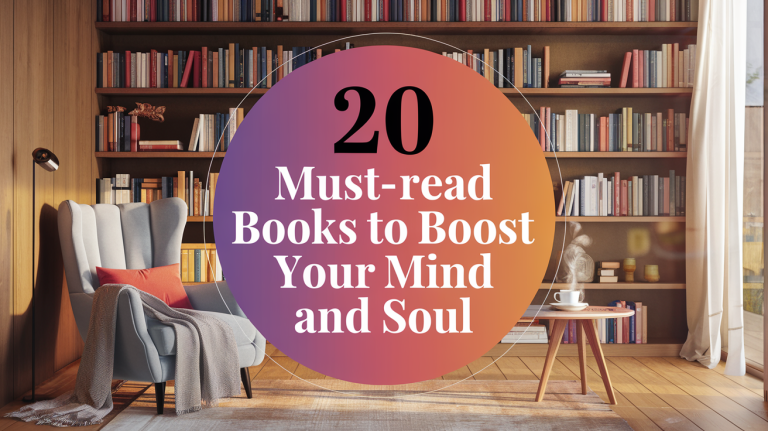Mindfulness Exercises for Anxiety: Find Inner Peace
Living with anxiety can feel overwhelming. But, I’ve found that mindfulness exercises help me find inner peace. Mindfulness is more than a trend; it’s a vital practice for everyone. It can be easily added to anyone’s daily life, no matter their skill level.
These exercises are great for managing stress and offering relaxation techniques for anxiety. They are accessible to everyone. I’ve learned that they can be incredibly effective.
Studies have shown mindfulness meditation’s impact on reducing anxiety. This includes nursing students and adolescents. As I explore these exercises, I become more aware of my emotions and thoughts.
This awareness helps me navigate daily life more easily. It improves my mental health and overall well-being.
As we explore these exercises further, I hope to inspire others. I want to show them how mindfulness can help cope with anxiety. It can lead to a more balanced and peaceful mind.
Understanding Mindfulness and Its Benefits for Anxiety
Mindfulness is now seen as a strong way to handle anxiety and stress. It’s a type of meditation that helps us stay in the present moment. It teaches us to accept our thoughts and feelings without judgment.
People who practice mindfulness often see their anxiety levels drop. For instance, those in an eight-week mindfulness program felt better emotionally than a control group. This shows mindfulness can really help with anxiety.
Science backs up mindfulness for stress relief. It makes our minds more flexible and focused. Regular practice can help us deal with stress better, improve our concentration, and even lower blood pressure.

Adding mindfulness to our daily lives helps with anxiety and boosts overall well-being. It helps us understand ourselves better and face challenges more easily. Mindfulness is not just a quick fix; it’s a lasting change that brings peace in our busy lives.
The Science Behind Mindfulness and Anxiety Reduction
Research on mindfulness has grown a lot, showing its big impact on mental health, especially with anxiety. It’s amazing that regular mindfulness can change the brain in just eight weeks. This gives hope to those looking for ways to handle anxiety.
Over 25,000 people have tried mindfulness-based programs and seen big improvements. These programs help with stress, pain, and chronic illnesses. Mindfulness-Based Cognitive Therapy has been shown to cut depression relapse by nearly 50%. It works as well as long-term medication.
Long-time meditators show big changes in their brains from all their practice. Studies show that mindfulness programs like Mindfulness-Based Stress Reduction (MBSR) help with stress and are as good as antidepressants. These benefits last for up to 60 weeks.
Meta-analyses show that mindfulness therapy is effective in reducing anxiety and improving mood. People with anxiety and mood disorders see big improvements. These benefits last even after follow-up checks.
Studies also show that mindfulness boosts memory and self-awareness. It helps develop healthier thinking patterns. Long-term mindfulness practitioners even protect their brains from age-related changes, showing cognitive benefits.
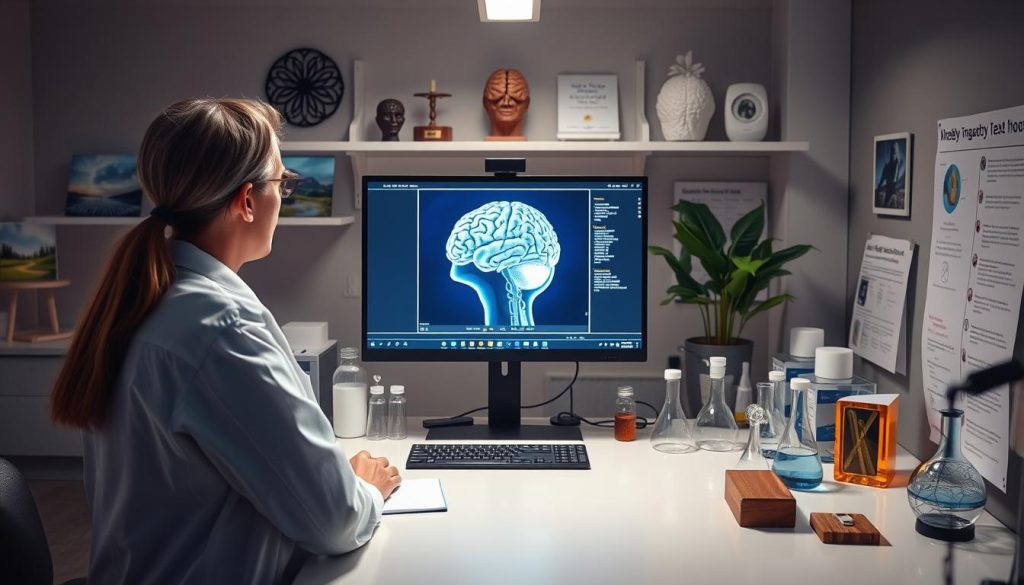
Mindfulness Exercises for Anxiety: Simple Techniques to Calm Your Mind
Adding mindfulness exercises for anxiety to my daily life has changed how I handle stress. Simple techniques help calm my mind and change negative thoughts. Here are two easy yet powerful exercises.
Five Senses Exercise: Grounding Yourself in the Present
The Five Senses Exercise helps me stay present. I focus on each sense to anchor my mind. Here’s how I do it:
- Notice five things I can see.
- Identify four things I can touch.
- Listen for three sounds around me.
- Identify two things I can smell.
- Focus on one thing I can taste.
This exercise calms my mind and connects me to my surroundings. It’s a favorite of mine for managing anxiety.
The Raisin Exercise: A Delicious Path to Awareness
The Raisin Exercise makes me appreciate food more. I choose a raisin and study it closely. I look at its color, texture, and shape. Then, I smell it.
Next, I eat it slowly, enjoying every bite. This simple act helps me focus and feel more aware. It’s a great way to calm my anxious thoughts and enjoy the moment.
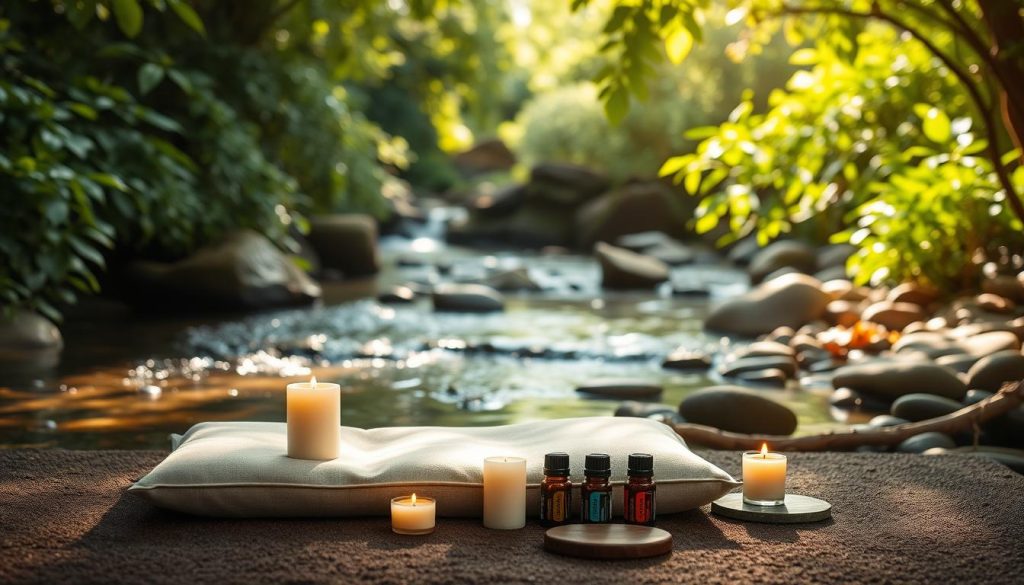
Integrating Breathing Exercises for Anxiety Relief
Adding breathing exercises for anxiety to my daily life has been a game-changer. These methods help me feel in control when I’m anxious. They also bring calm and relaxation. Learning to focus on my breath is a key way to reduce stress and anxiety.
Focus on Your Breath: A Powerful Tool for Calmness
Just focusing on my breathing can change my mood a lot. It makes me more aware of my body and the moment. A method I find helpful is square breathing, which involves:
- Breathe in for a count of four.
- Hold the breath for a count of four.
- Exhale for a count of four.
- Hold again for a count of four.
This method helps balance my body’s oxygen and carbon dioxide levels. It helps my body relax instead of being in fight or flight mode.
Deep Breathing: Techniques to Alleviate Anxiety Symptoms
Deep breathing exercises are great for managing anxiety. Diaphragmatic breathing is one effective way. It involves deep breaths from the diaphragm, not just shallow chest breaths. This improves oxygen flow and can lower anxiety. Other techniques include:
- Progressive muscle relaxation (PMR): I tense and relax major muscles for ten seconds each to release tension.
- Mindful breathing: Paying attention to my breath helps me focus and calm my mind.
Regularly practicing these breathing exercises brings calm to me. They help me deal with stress better, leading to clearer thoughts and less emotional strain.
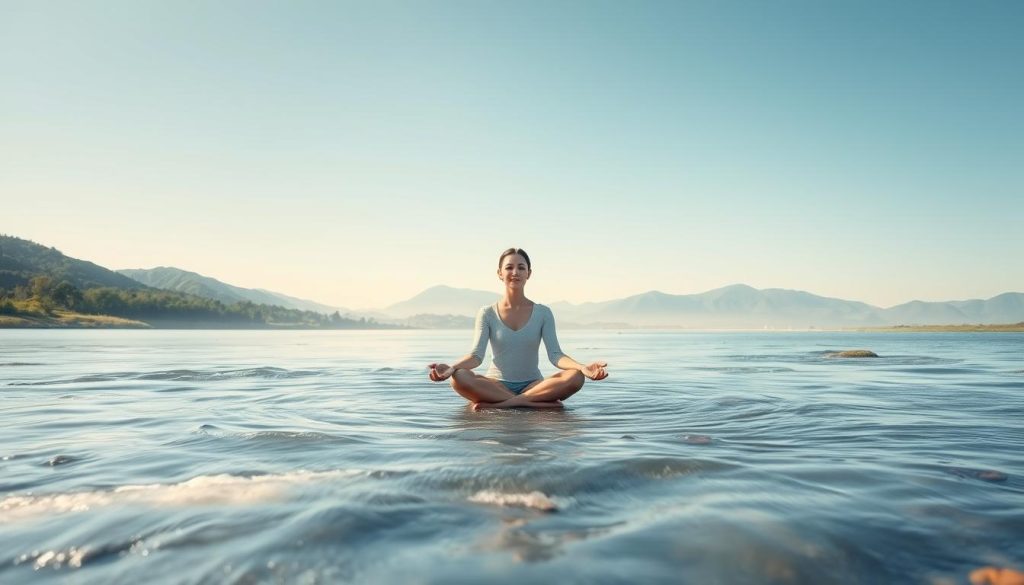
The Role of Mindful Meditation in Anxiety Management
Anxiety affects nearly 20% of adults in the United States, impacting over 40 million people. It includes generalized anxiety, panic, phobias, and social anxiety. Mindful meditation has been a key tool for me in managing my thoughts and feelings.
Studies from the University of Waterloo show that 10 minutes of daily meditation can reduce anxiety. Participants in this study had better focus and less wandering thoughts than those without meditation. Mindfulness is also shown to improve stress resilience and overall well-being.
Mindful meditation is easy to start because it doesn’t need special equipment. It has no side effects and can be done anywhere. It’s as effective as some traditional treatments and cognitive-behavioral therapy.
Stress can lead to health problems like high blood pressure and chronic pain. Mindful meditation has helped me stay mentally clear and relaxed. It helps me handle stress better and accept tough emotions without judgment.

Using Body Scan Techniques for Complete Relaxation
The body scan for relaxation is a powerful mindfulness technique. It helps me feel aware and calm. By focusing on my body, I release stress and tension.
When I notice sensations like tightness or warmth, it connects my mind and body. This connection is key to feeling whole.
Practicing this technique daily brings many benefits. Studies show it lowers cortisol, the stress hormone. Even a short version can help manage anxiety.
Adding it to other mindfulness techniques makes it even more effective. It helps me find peace, even when things get tough.
During the body scan, I learn where I hold tension. It shows me how to relax those areas. I can do it anywhere, making it easy to add to my daily routine.
Research says being mindful of my body helps me handle stress better. By embracing sensations and letting my mind wander, I feel free. Regular practice trains my mind and body, leading to more relaxation and well-being.
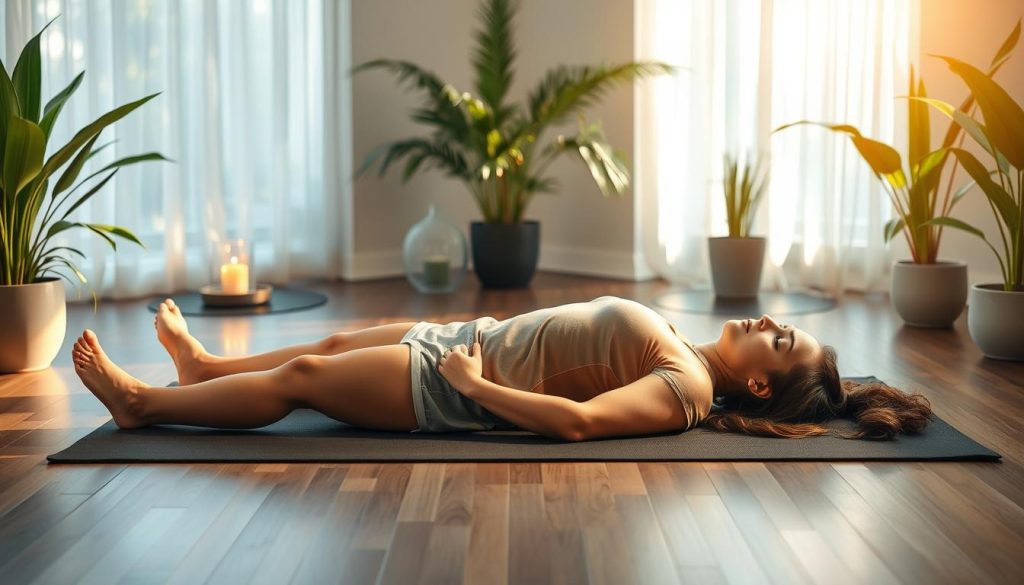
How to Start a Morning Journal for Mindfulness
Starting a morning journal can be a great way to practice mindfulness. It helps me reflect on my feelings and plan my day. Journaling lets me share my emotions and understand my thoughts better, which helps with anxiety.
Journaling to Set Intentions and Understand Emotions
I start my day by answering a few questions that help me think deeply and plan. This usually takes a page in my journal. It helps me stay focused. Here are some questions I ask myself:
- What are my soul’s needs today?
- What excites me the most about today?
- What goals do I want to welcome?
- What am I grateful for right now?
- What actions can I take to embrace personal joy?
- What can I do to bring joy to others?
- What praises or prayers do I want to acknowledge?
- How do I want to feel by the end of the day?
- What tasks will help me achieve my goals more easily?
Adding these reflective questions to my morning routine boosts self-compassion and resilience. Studies show that writing down our thoughts can lower anxiety and improve our mood. After journaling, I often feel less anxious and more calm.
My journaling also includes activities like enjoying coffee, stretching, or praying. These add to my mindfulness practice. Each question helps me choose how to direct my emotions and actions positively.
Incorporating Gratitude Exercises into Your Routine
I found that gratitude exercises can really help with anxiety and improve well-being. These practices make us feel more positive and support mindfulness. Adding gratitude to my daily life has made a big difference in my emotional health.
The Power of Positive Reflection in Daily Life
Being thankful regularly can make us happier and more satisfied with life. I started by keeping a daily gratitude journal. Writing down three things I’m thankful for each day helps me focus on the good things.
Studies show that gratitude exercises have many benefits. They can improve sleep, physical health, and relationships. They also boost motivation and satisfaction in our daily activities.
Writing gratitude letters has also made me happier. It’s shown to have long-lasting positive effects. Saying thanks or writing notes has strengthened my relationships and built a supportive network. Gratitude exercises have helped me with anxiety, reducing stress and building emotional strength.
Mindfulness Activities for Calmness: Finding Peace in Daily Tasks
Adding mindfulness to my daily routine makes me feel calm. It’s easy to find peace by making everyday tasks mindful. This way, I live life more fully and feel less anxious.
Even simple tasks can be mindful. Like washing dishes, focusing on the water and soap’s smell makes it refreshing. Being present in these moments makes life more enjoyable.
Whether I’m cooking or watering plants, each task is a chance to slow down. It helps me breathe and relax.
- Mindful eating makes me enjoy my food more, connecting me to the moment.
- Mindful gardening helps me relax and feel closer to nature.
- Mindful driving improves my focus, making my trips safer.
Kids can also enjoy mindfulness. Games like the wiggle and freeze game help them notice their body. A five senses scavenger hunt keeps them focused on the present.
By diving into these mindfulness activities, I feel calm and happy all day. Mindfulness isn’t just for quiet times. It can be part of our daily lives.
Creating Mindfulness Practices for Stress Reduction
I’ve learned how making mindfulness practices personal can really help with stress. These custom practices can lessen stress and anxiety. The first thing is to set clear goals for what you want to achieve, like feeling calmer or more balanced.
It’s also important to pick the right exercises. Mindful breathing and body scans are great. They help me stay present and focused, moving my mind away from worries. The “Come Back” technique, for example, tells me to breathe deeply when I feel anxious. This helps me stay in the moment.
Having a quiet, safe space is key for my mindfulness practice. This space makes me feel comfortable and open, letting me focus better. I might light a candle or play soft music to help me connect with my thoughts and feelings.
Adding sensory experiences to mindfulness can make it even deeper. The “Three Senses” exercise, for example, helps me notice sounds, sights, and textures. Activities like sailing also bring me closer to the present, making me feel calm.
Creating mindfulness practices that fit my needs has really helped. These practices change how I deal with daily stress, improving my well-being and making every moment count.
Walking Meditation: Moving Calming Practices into Action
Walking meditation for anxiety combines movement with mindfulness. It focuses on the present moment while walking. This helps you become more aware of your body and surroundings.
I start with a short walk, lasting 5 to 20 minutes. Walking slowly and taking small steps increases mindfulness. This slow pace lets me feel each step and the ground beneath.
Engaging my leg muscles keeps me grounded. It helps me stay focused on the moment.
- Walking meditation improves balance and brings peace.
- It can help with sleep, stress, and anxiety.
- It also manages mild to moderate depression.
- Being aware of my surroundings keeps me safe and focused.
I count my steps up to 10 and then back to one. This keeps my mind on track. If my thoughts stray, I bring my focus back to walking.
I also listen to sounds and feel sensations around me. This makes the experience richer. It highlights the beauty often missed when we’re distracted.
Walking meditation is a gentle yet powerful way to connect with the present. It turns movement into a mindful experience. This brings peace into our busy lives.
Establishing a Consistent Mindfulness Routine
Creating a mindfulness routine is a journey to inner peace and emotional balance. It helps me manage stress and improve my well-being. The beauty of mindfulness is that it can be simple and quick. Even small practices can lead to big changes over time.
How Often Should You Practice Mindfulness Exercises?
For beginners, start with a frequency that feels right and doable. Even short practices can make a big difference. Here are some tips:
- Start with 5-10 minutes daily, focusing on breathing or a short meditation.
- As you get used to it, increase the time.
- Make mindfulness a part of daily activities like eating or walking.
- Sticking to it helps make mindfulness a natural part of your life.
By trying different things, I find what works best for me. I aim to make mindfulness a positive part of my day. This not only helps with anxiety but also boosts my mental health.
Combining Mindfulness with Other Anxiety Coping Strategies
I found that mixing mindfulness with other strategies helps a lot. Mindfulness, like meditation and deep breathing, helps us stay in the moment. This is key to handling anxiety better.
By paying attention to our thoughts and feelings, we can better manage anxiety. This approach has helped me a lot.
Exercise is also great with mindfulness. Just a 30-minute walk can improve my mood and distract me from worries. It makes me feel better by releasing happy chemicals in my brain.
While walking, I focus on what’s around me. This keeps me grounded and present.
Cognitive Behavioral Therapy (CBT) has been very helpful too. It teaches us to fight negative thoughts. Using CBT with mindfulness helps me understand my mind better.
Journaling is another tool I use. It lets me see my thoughts and find patterns. This helps me know what triggers my anxiety.
Also, avoiding caffeine is important. Drinks like coffee can make anxiety worse. Instead, I use deep breathing to calm down.
Adding mindfulness to my daily life has changed how I deal with anxiety. This mix of strategies helps me stay calm and focused.
Exploring Mindfulness-Based Stress Reduction (MBSR)
Mindfulness-Based Stress Reduction (MBSR) is a well-known program for managing anxiety and improving well-being. It was created by Jon Kabat-Zinn at the University of Massachusetts Medical Centre. This program combines mindfulness meditation and yoga to connect the body and mind.
By following the MBSR program for anxiety, I’ve seen big improvements in my mental health. My anxiety symptoms have decreased, and I’m better at handling stress every day.
Research shows MBSR’s benefits, like better well-being and less psychological distress. People have seen less anxiety, burnout, and depression. Mindfulness also helps with attention, sleep, and heart health, leading to a better life.
I’ve learned to fight off negative thoughts and reactions that cause anxiety. This is thanks to MBSR’s mindfulness practices.
If you want to start this journey, there are many resources available. “The Mindfulness-Based Stress Reduction Workbook for Anxiety” offers guided meditations and exercises. It helps with anxiety and understanding what triggers it.
With this approach, I became more present and focused. I’ve made big steps in managing my fears and worries. You can find MBSR programs locally or online, making it easy to start your mindfulness journey. This way, you can enjoy the lasting benefits of MBSR.


